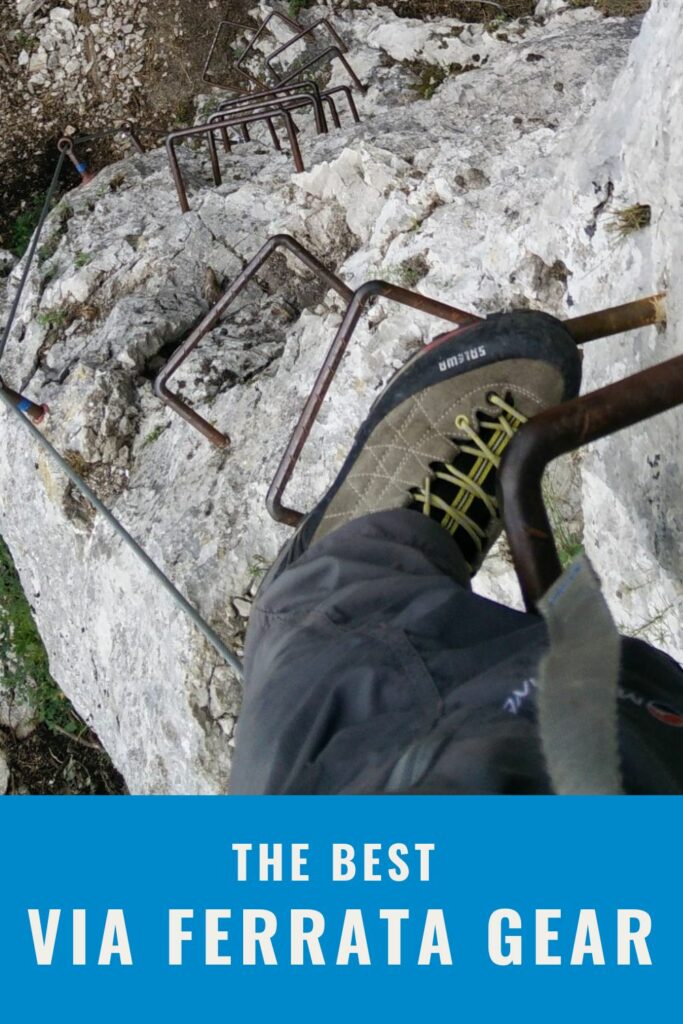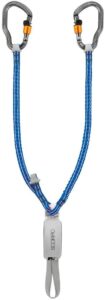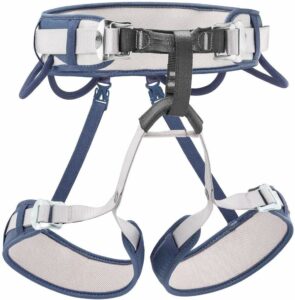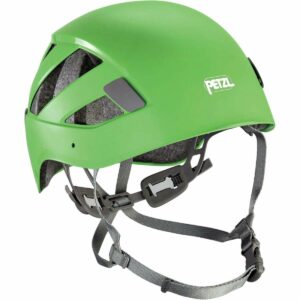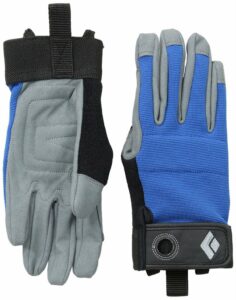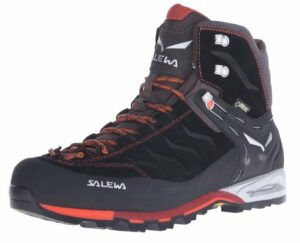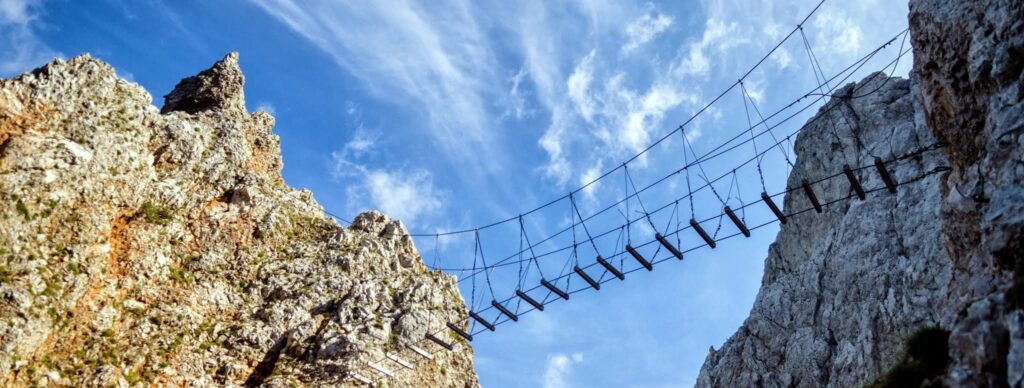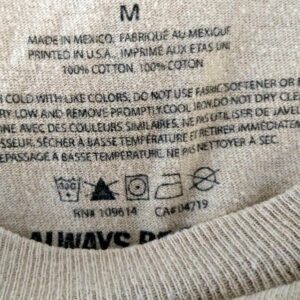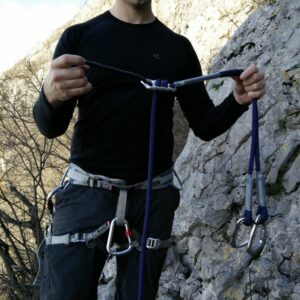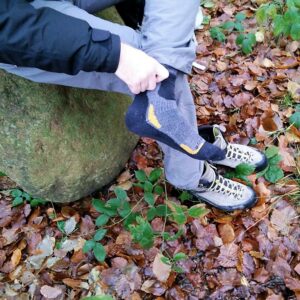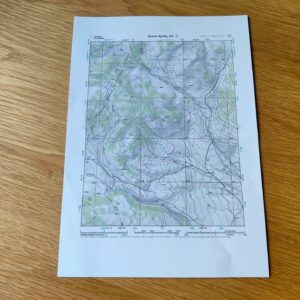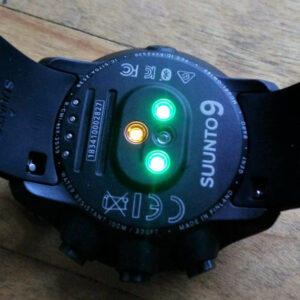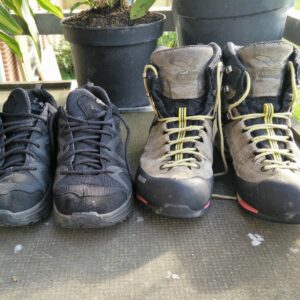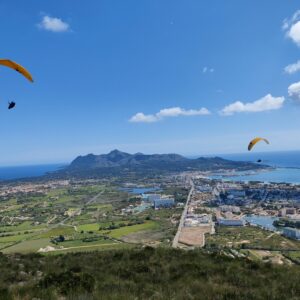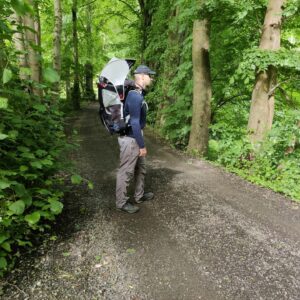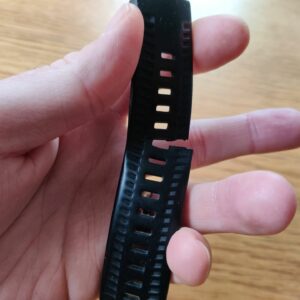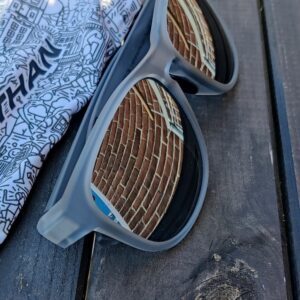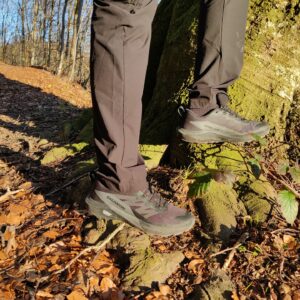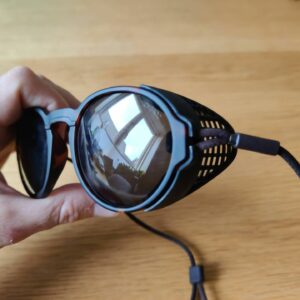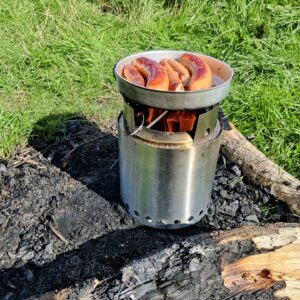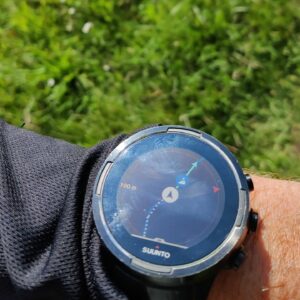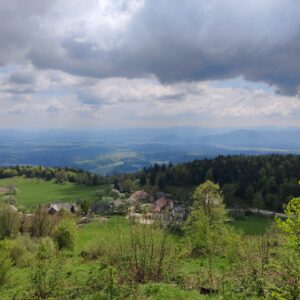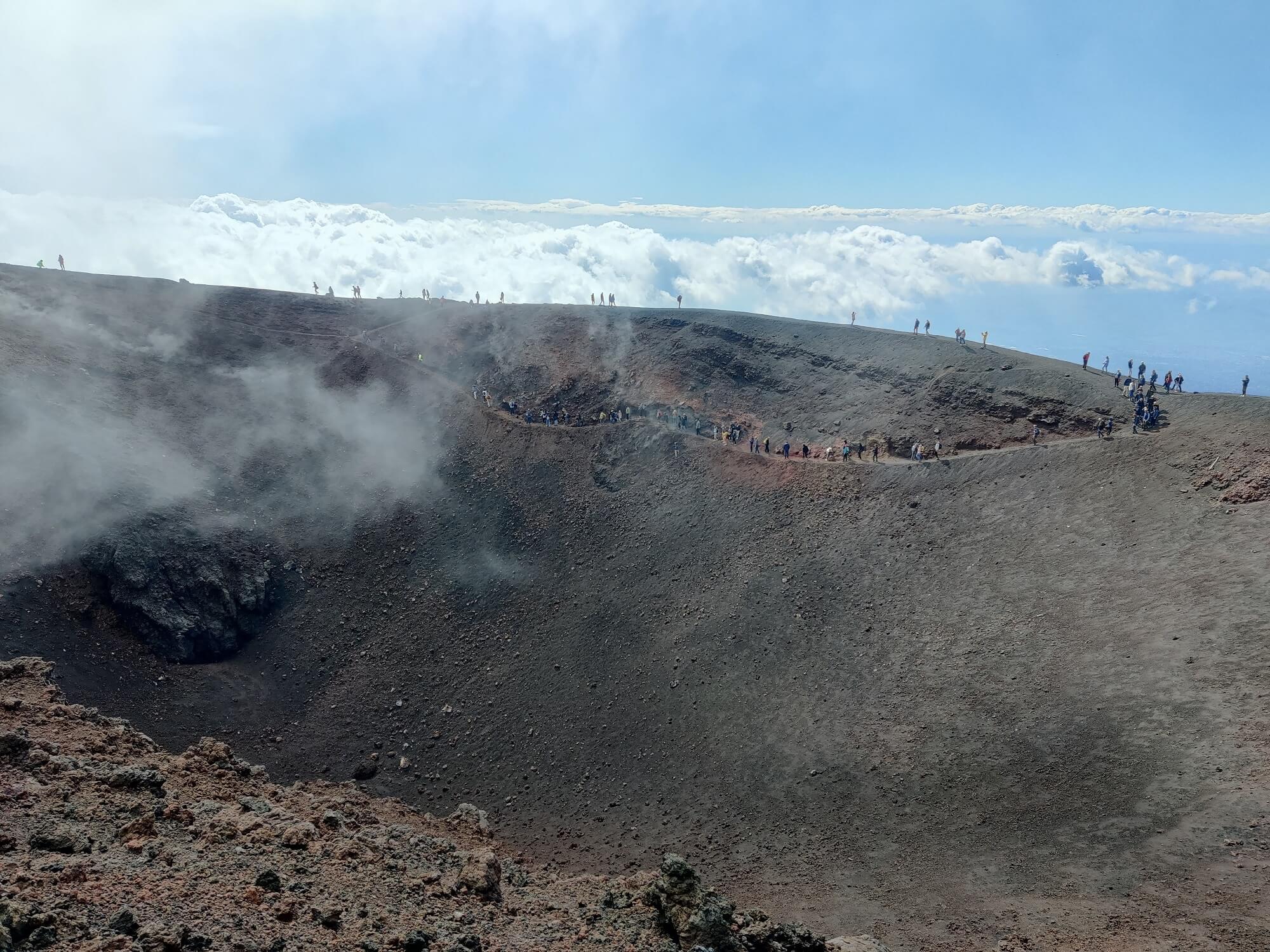In the following we selected and reviewed the best product within each category of via ferrata equipment. If you are new to via ferrata trails, you should first read our article How to Use Via Ferrata Equipment to understand how via ferrata equipment works (the article includes many photos and a video for better understanding). Nevertheless, if you have no mountaineering or climbing experience, we recommend taking a course or tackling your first via ferrata with an experienced guide.
Via Ferrata Equipment:
- Via ferrata set
- Climbing harness
- Climbing Helmet
- Via Ferrata Gloves
- Hiking/mountaineering boots
1. The Best Via Ferrata Equipment Review
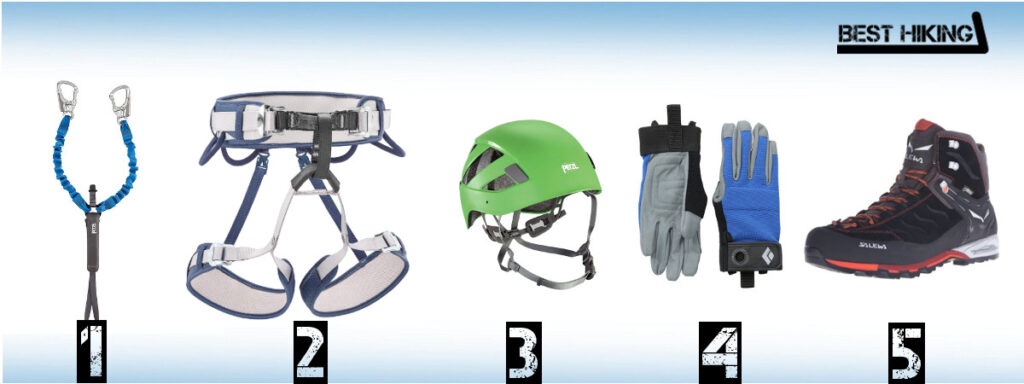
The Best Via Ferrata Equipment
The Best Via Ferrata Equipment – List
- Via Ferrata Set – Petzl Scorpio Vertigo
- Climbing Harness – Petzl Corax
- Climbing Helmet – Petzl Boreo
- Via Ferrata Gloves – Black Diamond Crag
- Hiking/Mountaineering Boots – Salewa Mountain Trainer Mid GTX
1. Via Ferrata Set – Petzl Scorpio Vertigo
A via ferrata set is used to attach your climbing harness to the steel cable that runs along the trail. It consists of an attachment loop, energy-absorption system, two lanyards and two carabiners. The attachment loop allows you to attach the set to the climbing harness while the carabiners can be hooked to the steel cable. The energy-absorption mechanism is the most important part and ensures that a potential fall would be stopped gradually rather than abruptly, resulting in injuries. There are different types and designs of via ferrata sets, but modern via ferrata sets mainly have the so-called V design and a tear-out webbing for energy-absorption.
We recommend the Petzl Scorpio Vertigo via ferrata set because it offers great functionality. The set has two Vertigo carabiners, two retractable arms and a tear-out webbing shock absorption mechanism. Furthermore, the set is equipped with an additional short arm (seven centimeters long) for pauses along the trail. The Vertigo carabiners allow you to quickly pass iron rods as they have large openings for easy attachment to the cable. They also don’t need to be screw-locked. The retractable arms measure 60 centimeters in length when they are extended and therefore, they offer great freedom of movement. When retracted they measure only 36 centimeters in length, so they don’t get in the way during the ascent. The tear-out webbing is stored in a pouch for better protection. The pouch can be opened to inspect the condition of the tear-out webbing. The additional short arm comes in handy for rest phases – as it measures only seven centimeters in length, it keeps you in place while you drink, eat etc. However, the short arm doesn’t come with a carabiner – you need to purchase the carabiner separately.
Weight: 380 g
Pros:
- Short arm for rests
- User-friendly carabiners
- Inspectable energy absorber
- Retractable arms
Cons:
- /
Also available at:
2. Climbing Harness – Petzl Corax
There are three different types of climbing harnesses – sit harnesses (worn around the hips), chest harnesses (normally worn together with sit harnesses) and full-body harnesses. For via ferrata trails mostly sit harnesses are worn. However, if you are planning to carry a heavy backpack you might want to wear a full-body harness. The gravity points of full-body harnesses are placed higher than at sit harnesses. If you carry a heavy backpack with a sit harness, you could suffer additional injuries in case of a fall as the weight of the backpack could yank you backwards.
We recommend the Petzl Corax climbing harness (sit harness) but only for trips without a particularly heavy backpack. The Petzl Corax climbing harness is very light and comfortable – also during rest phases because it has foam padded leg loops and waist belt. The leg loops are adjustable and thus you can easily put the climbing harness on without first taking off your boots. Furthermore, due to the adjustable leg loops, the climbing harness will fit comfortably regardless of the clothing you wear. The climbing harness is equipped with a standard attachment point which allows you to easily attach the via ferrata set with a carabiner or a cow hitch knot. The climbing harness comes in two different sizes – M (fits waists from 65 – 96 cm) and L (fits waists from 76 – 107 cm).
Weight: from 490 to 540 g (depending on the size)
Pros:
- Lightweight
- Comfortable fit
- Highly adjustable
- Beginner-friendly
Cons:
- Not ideal for heavy backpack loads
Where to buy? Also available at:
3. Climbing Helmet – Petzl Boreo
Falling rocks are common on steep via ferrata routes, making a helmet absolutely essential.
We recommend the Petzl Boreo climbing helmet because it is not only light and comfortable, but it also provides good protection. The helmet has an ABS injected shell and foam lining. The headband is easy to adjust even while you are wearing the helmet. It also has an adjustable chinstrap. The helmet features relatively large vents for comfortable wear in warm conditions. It also has integrated clips for attaching a headlamp and comes in several different colors and in two different sizes; size M fits head circumferences from 48 to 56 centimeters and size L fits head circumferences from 53 to 61 centimeters.
Weight: from 285 g (depending on the size)
Pros:
- Comfortable fit
- Good ventilation
- Headlamp-ready
- Reliable protection
Cons:
- /
Also available at:
4. Via Ferrata Gloves – Black Diamond Crag
Gloves are worn on via ferrata trails for better grip. They also protect your hands against blisters which can occur due to the friction between the skin and the cable/rock. Furthermore, they provide insulation which is very useful because steel cables are usually much colder than the surroundings.
We recommend the Black Diamond Crag gloves which are designed especially for via ferrata trails. The gloves have palms made of synthetic leather and thus they provide a firm grip. The upper part is made of mesh fabric for good breathability. The knuckles are padded to protect your hands from abrasion from rocks (when reattaching the carabiners for example). The gloves are inexpensive and available in three different colors – red, black and blue. Please note that these gloves do not provide sufficient insulation for doing via ferrata trails in winter (although many via ferrata trails are not even accessible in winter as the cable is covered with snow).
Weight: 70 g (a pair)
Pros:
- Affordable
- Great grip
- Padded protection
- Breathable
Cons:
- Not for winter use
5. Boots – Salewa Mountain Trainer Mid GTX
Footwear for via ferrata must be robust, stiff, and supportive. Mid- or high-cut boots with durable uppers and stiff midsoles provide stability and protection on rocky terrain.
We recommend the Salewa Mountain Trainer Mid GTX boots for via ferrata trails. The Salewa Mountain Trainer Mid GTX boot is designed for technical hiking and features nubuck leather upper. Therefore, it provides good breathability and abrasion resistance. The boot is additionally protected against abrasion with an all-around rand made of polyurethane. For good ankle support the boot features the 3F System (semi-stiff rubber inserts in the ankle area). The lacing comes right down to the toe (climbing lacing) for a more precise fit – which you will appreciate when ascending technically challenging trails. For more footwear options check out our selection of the Best Hiking Boot Brands which includes five different pairs of boots – all of them suitable for via ferrata trails. For general information about footwear read our Guide to Hiking Footwear.
Weight: 1260 g (a pair)
Pros:
- Excellent support on rockz terrain
- Durable build
- Stable and precise fit
- Protective rand
Cons:
- Slightly heavier than lightweight hiking options
Where to buy? Salewa mens MS Mountain Trainer Mid Gore-TEX High Rise Hiking Shoes, Grey (Charcoal/Papavero), 12 US Also available at:
2. Via Ferrata – Basics
What is a via ferrata?
A via ferrata is a technically demanding trail equipped with a steel cable running along the route. In addition, it may also include metal rungs, ladders, suspension bridges, and carved footholds. A via ferrata allows you to reach otherwise inaccessible summits without needing advanced climbing skills, which is why these trails are becoming increasingly popular among hikers and trekkers.
However, via ferrata trails are not suitable for those afraid of heights, as they often traverse exposed ridges or climb nearly vertical rock walls.
Short history of Via Ferrata trails
The term via ferrata means iron trail in Italian. The first such routes were constructed during World War I by the Italian army to help soldiers access strategic high peaks, where they established observation points to monitor enemy movements.
After the war, many new via ferrata trails were built—not for military purposes, but for hikers, alpinists, and mountaineers seeking adventurous routes in the high mountains.
Where are via ferrata trails?
Today, there are thousands of via ferrata routes worldwide. They are especially common in the Alps (Austria, Italy, France, Switzerland, Germany, Slovenia), but you can also find them in the United States, Canada, New Zealand, and other mountain regions.
For inspiration, check out our via ferrata trail reviews on Nail the Trail – each includes detailed descriptions and GPS routes.
How are via ferrata trails rated in terms of difficulty?
Not all via ferrata routes are created equal. Some are suitable for beginners with little climbing experience, while others are very difficult and require advanced strength, endurance, and technical ability. To help climbers choose appropriate routes, several grading systems are used worldwide.
A–F (German/Austrian system):
- A (Easy): Mostly hiking with some cable protection. Gentle terrain with limited exposure.
- B (Moderate): Steeper rock faces, ladders, and more continuous cable protection. Exposure increases.
- C (Difficult): Vertical sections requiring good strength, balance, and confidence with equipment.
- D (Very Difficult): Long vertical climbs with overhanging sections, demanding upper-body strength.
- E (Extremely Difficult): Sustained overhangs and very exposed climbing. For experienced climbers only.
- F (Severe/Pro): Maximum difficulty; extreme exposure and technical demands, often suitable only for pros
French system (F to ED):
- F (Easy)
- PD (A Little Difficult)
- AD (Fairly Difficult)
- D (Difficult)
- TD (Very Difficult)
- ED (Extremely Difficult)
Italian system:
- Uses a numeric scale (1–6) similar in meaning to the German grades.
